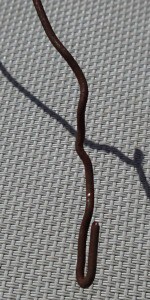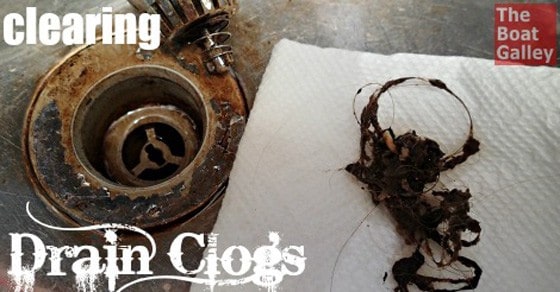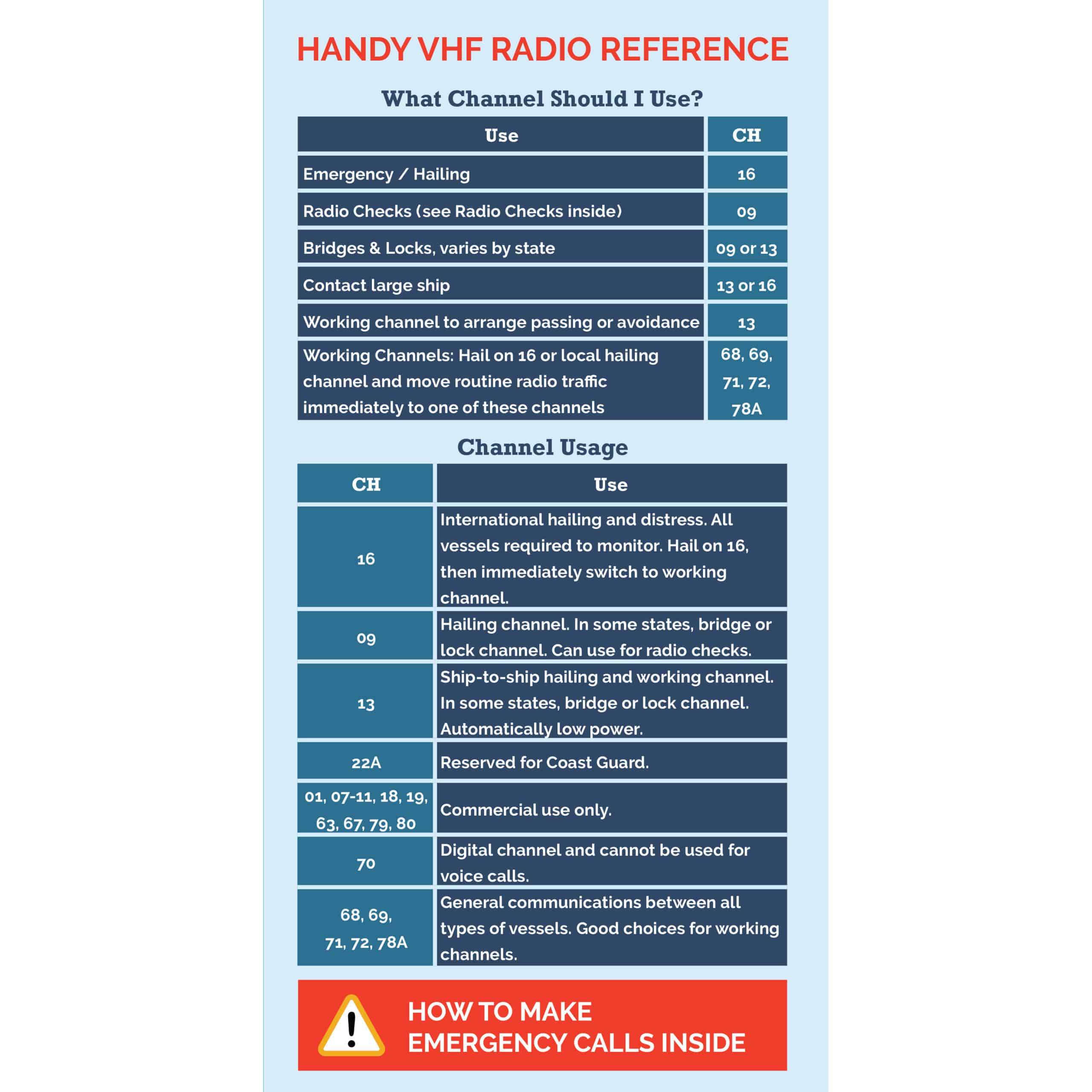Not a pretty cruising picture, I know.
Ever since we got Barefoot Gal in the water and I began putting water down the galley drain, I’ve had problems with it being a very slow drain.
I make sure to keep the strainer clean. I’ve put lots of boiling water down (every few days, in fact). Baking soda and vinegar. Super Digest-It. All helped to some extent, then things would be back to slow in a couple of days. Should I just chalk it up to being a small drain?
This morning, I made one more stab at it, getting out a really bright light and looking down. Lo and behold, I could see a few hairs wound around the crosspiece. I got a fork and pulled up . . . and got some gunk as well as hair.
More importantly, I pulled up the top end of a clump of nasty stuff. But I couldn’t get it through the drain opening to really clear it.
The fork was just shredding it. I tried an ice pick and the gunk just slid off.
I kept thinking that I needed a crochet hook . . .
 Finally I remembered the piece of wire that we had — not sure what it had originally been, but it was in a tool locker when we bought the boat and Dave kept it, thinking it might be useful . . . someday.
Finally I remembered the piece of wire that we had — not sure what it had originally been, but it was in a tool locker when we bought the boat and Dave kept it, thinking it might be useful . . . someday.
The end was even bent into a hook and I was able to easily pull the accumulated crud out of the drain. There was a lot more than in the picture at the top of this post, but I threw a bunch away before I thought to take a picture.
Amazing how well the drain works now!
And I’ll bet that you could do the same with the end of a roll of seizing wire . . . just unroll a bit, bend the end into a hook for the clean out (needlenose pliers work well for bending the hook), then clean it off and roll it back up.
NOTE: If you have a drain with larger openings, a Zip-It works wonders for stuff like this. Get them in home improvement stores or from Amazon (less than $5 and free shipping when I wrote this). Love this for our home drains, but we have tiny drain openings on Barefoot Gal and the Zip-It won’t fit.
Flatten the learning curve with practical how-to info that gives you the confidence to step into life aboard.
Start Learning Today

Carolyn Shearlock has lived aboard full-time for 17 years, splitting her time between a Tayana 37 monohull and a Gemini 105 catamaran. She’s cruised over 14,000 miles, from Pacific Mexico and Central America to Florida and the Bahamas, gaining firsthand experience with the joys and challenges of life on the water.
Through The Boat Galley, Carolyn has helped thousands of people explore, prepare for, and enjoy life afloat. She shares her expertise as an instructor at Cruisers University, in leading boating publications, and through her bestselling book, The Boat Galley Cookbook. She is passionate about helping others embark on their liveaboard journey—making life on the water simpler, safer, and more enjoyable.










Jan Bogart says
Hair in the galley?
The Boat Galley says
The sink has been slow since we began using the boat. I usually wear my hair in a pony tail, as does Dave, and we certainly don’t comb our hair there (I comb mine in the other hull and Dave does his in the cockpit), I don’t notice hair when I’m vacuuming the floor except in the head . . . so I’m not sure where it came from. But I’ll sure be on the lookout!
Andrew Mcp says
Boat goblins. They are on boats. They steal tools and put them in the bilge or in other strange places in the boat.
Marilyn says
The draining galley sink seemed to get slower as the cruising season went on and by late spring I had to use the plunger(plumbers friend) to loosen up the gunk in the hose.
I finally got smart and when the boat is in the work yard each October, and the gunk has dried out in the hose after the boat has been on the hard all summer…I carefully bring down the hose Rick is using to clean the topsides and shoot water under pressure down the drain..cleaning it out in preparation for another cruising season. This has worked well for me the past several years.
but make sure you dont clean out the gunk on the new bottom paint..that didnt make hubby very happy.
Jan Bogart says
Previous owners!!!
Frank Collins says
You might try one of the flexible plastic drain opener. I first discovered it while at home after washing the dogs in the bath tub. Its approximately 18 inches long, very flexible and has barb type hooks. The tool is very flexible and you would be amazed on how easy it goes down your drain and all the nasty hair and other junk it grabs with just a few pulls. Rolls up small and stores in a small space. No chemicals needed.
Carolyn Shearlock says
Yes, that’s the Zip-It (probably has other names as well) I mentioned in the article — they’re wonderful but too big to go down the small openings in this drain.
Mike O'Quin says
Now you need to go back and use your hot water with baking soda and vinegar to clear the rest of the drain.
Carolyn Shearlock says
Done!
Andrew Mcp says
Boat goblin hair.
Ken Roach says
For tiny drains like ours, you can make use of what’s usually a drawback: the ‘hook’ side of Velcro will stick to hair and debris in a drain. I use it on our 1 1/4″ cockpit drains and on the even smaller scupper and settee drain tubes.
There are a handful of hook-and-loop style miniature drain snakes on the market, including the as-seen-on-TV “Turbo Snake” I use. I also found an even smaller one on Amazon called a “drain millipede”.
While I’m no fan of single-purpose tools you buy for ten bucks on the Internet, I’m sure that a scrap of Velcro and a bit of wire or metal rod would do the job too and be improvisable anywhere.
Laura says
I use a mesh sink strainer (similar to this:http://amzn.to/2DfQS2t) in my galley sink and in my kitchen sink at home. It filters out a lot more “tiny bits” and hair than a traditional sink strainer, which helps to prevent gunk from forming further down the line.
Dave Skolnick (S/V Auspicious) says
If you have a real slow drain, as is often caused by the build-up of debris like you experienced Carolyn the fastest approach is to close the thru-hull and pull the hose out completely and flush it, preferably with hot water. Clean both ends (the thru-hull and the sink drain) and reassemble. In the end it is faster and definitely most effective.
Hair is bad. Hair and soap are worse. Uggh.
Carolyn Shearlock says
I was trying to avoid removing the whole hose. If I hadn’t seen anything, that would have been the next step.
Molly SV Sabai says
Our rule on the boat, in out camper, in our outdoor adventure vehicles: Always have one wire coat hanger. You can hang clothes on it if you wish but you can – and we have – made tools from them.
Carolyn Shearlock says
Good rule! We try to always have one, but they’re getting hard to find!
Jane Head says
Yes! As we prepare for the summer boating season I put on board 1 wire coat hanger. Last year’s hanger saved the day when a small y-shaped stick wedged itself in the engine water intake hose. My hanger “hook” to the rescue!
Never leave the dock without one!
Jane Head
s/v Ibis